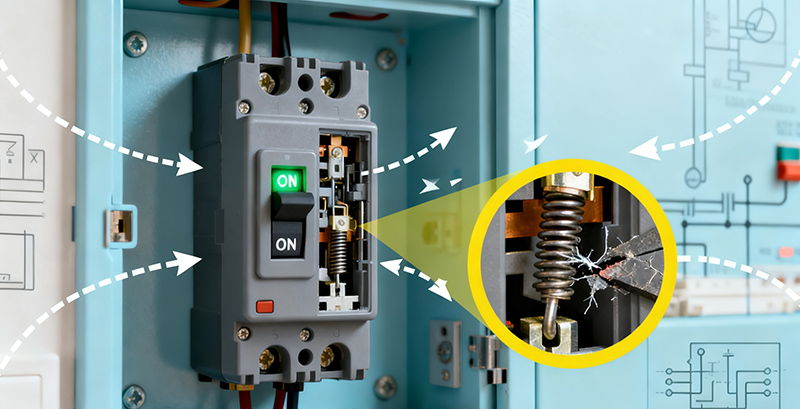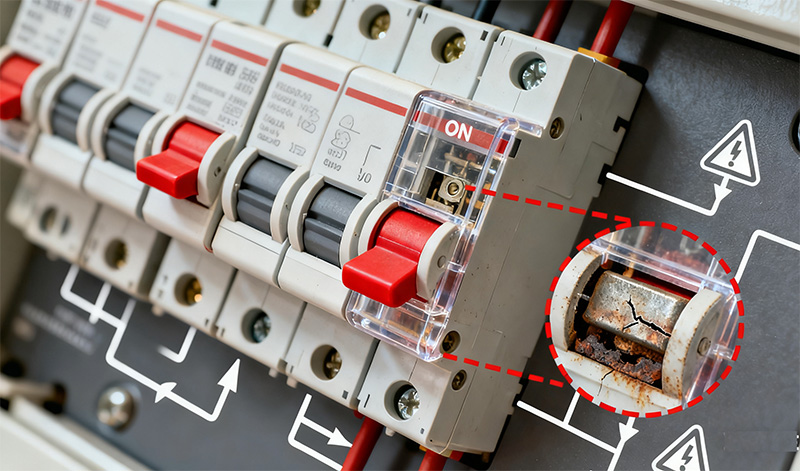Get quick appointment for technical support!
Can Circuit Breakers Go Bad Without Tripping?
Oct 01,2025
Circuit breakers are the silent protectors of every electrical system. They are designed to automatically shut off power when too much electricity flows through a circuit, preventing overheating, fire, and equipment damage. But what if the breaker doesn’t trip? Can it still go bad?
The simple answer is yes—a circuit breaker can fail without ever tripping. This kind of failure, often called a silent breaker failure, happens when internal components stop functioning properly. The breaker may still appear “ON,” but it no longer provides the protection. When this occurs, your home or business may be at risk without your knowledge.
In this article, we’ll explain how and why circuit breakers can go bad without tripping, what warning signs to look out for, and what steps you can take to stay safe.

What Happens When a Circuit Breaker Fails Silently?
A circuit breaker’s primary job is to “trip” during an overload or short circuit. This mechanical action cuts power instantly, protecting the wiring and connected devices. However, internal parts—such as springs, contact points, and thermal sensors—become damaged over time. When this happens, the breaker might look fine from the outside but be faulty internally..
The danger lies in the fact that you can’t see this failure. A faulty breaker might stay in the “ON” position, allowing unsafe current to flow. This could lead to overheating, damaged wires, or even electrical fires if left unchecked.
So, a breaker can absolutely go bad without tripping—and this type of hidden failure is more common than most people realize.
Common Signs of a Bad Circuit Breaker
Although a faulty breaker might not trip, there are often signs that something isn’t right. Watch out for these telltale signs:
1. Burning Smell or Scorch Marks
If you detect a burning odor coming from your electrical panel or see dark marks around the breaker, this indicates overheating. Heat buildup usually means the breaker isn’t cutting off power when it should, which can quickly turn into a fire hazard.
2. Hot Breaker or Panel
A properly working breaker should remain cool to the touch. If a specific breaker feels warm or hot, it’s a warning sign that it’s overloaded or malfunctioning. Heat can weaken internal parts and increase the risk of a serious electrical problem.
3. Flickering or Dimming Lights
When lights in your home flicker or dim for no obvious reason, the cause might be a failing breaker or loose connection. An unstable flow of current is a strong indication that the breaker is struggling to regulate voltage correctly.
4. Appliances Losing Power
If certain outlets or appliances turn off randomly or run inconsistently, that circuit’s breaker might not be maintaining proper voltage. A weak breaker can allow intermittent power loss even when it hasn’t tripped.
5. Buzzing or Humming Sounds
A faint buzzing noise from the electrical panel can be normal. However, loud humming or crackling usually means the breaker is overloaded or damaged internally and unable to trip as it should.
If you notice any of these symptoms, it’s best to take immediate action before the problem escalates.
Why Circuit Breakers Fail Without Tripping
Circuit breakers, like any mechanical device, can degrade over time. Here are the most common causes of silent breaker failure:
- Ageing Components: Over many years, springs and contacts lose tension, preventing proper tripping.
- Corrosion or Dust Buildup: Dirt or oxidation can block internal parts and stop the breaker from functioning.
- Loose or Damaged Wires: Poor connections create heat and arcing, which can permanently damage the breaker.
- Overuse or Overloading: Frequently overloaded circuits shorten a breaker’s lifespan and reduce its responsiveness.
- Defective or Low-Quality Units: Breakers from unreliable manufacturers may not meet safety standards and can fail prematurely
Regular maintenance and inspection can help catch these issues before they become dangerous.
What to Do If You Suspect Your Circuit Breaker Is Bad
If you suspect your circuit breaker has gone bad, follow these safety steps:
- Unplug Devices: Turn off or unplug all appliances connected to the affected circuit.
- Avoid Resetting Repeatedly: Continuously resetting a failing breaker can worsen the problem and cause further damage.
- Check for Heat or Odors: If you smell burning or feel heat, switch off the main power and call for professional help immediately.
- Call a Licensed Electrician: Testing or replacing breakers should only be done by qualified professionals. Electricians have tools to safely test voltage, continuity, and resistance to confirm whether the breaker is defective.
- Replace the Breaker: Once confirmed, the faulty breaker must be replaced with a certified unit of the correct amperage. Never attempt to repair a breaker—it’s safer and more reliable to install a new one.
Preventing Future Breaker Problems
The best way to avoid breaker failures is through regular inspection and using quality components.
Here are a few prevention tips:
- Inspect Your Electrical Panel Annually: Have a licensed electrician inspect the panel for signs of corrosion, overheating, or aging parts.
- Avoid Overloading Circuits: Distribute heavy power loads across multiple circuits instead of running them on one.
- Upgrade Old Equipment: If your panel or breakers are more than 20 years old, consider upgrading to modern, reliable units that meet current safety standards.
- Choose Trusted Brands: Using high-quality breakers greatly reduces the risk of failure.
Choose Reliable Breakers for Long-Term Safety
If you need to replace a faulty breaker, don’t settle for low-quality or uncertified products. Investing in durable, reliable electrical components is essential for safety and performance.
Westhomes Electrical is a trusted global supplier of circuit protection and power distribution solutions. With over 25 years of experience, Westhomes offers a full range of certified circuit breakers — from miniature and molded case breakers to advanced power control systems. Our products are built to meet international safety standards, providing lasting protection and stability for residential, commercial, and industrial applications. Get an expert today
--- END ---

